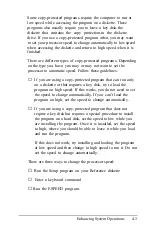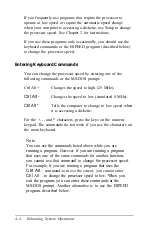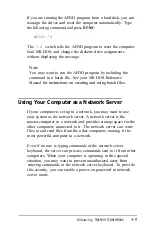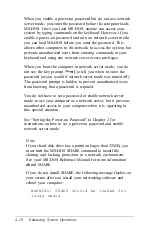
One batch file that you may find particularly useful is called
AUTOEXEC.BAT. Every time you turn on your computer,
MS-DOS looks for the AUTOEXEC.BAT file and
automatically executes each of the commands.
When you install MS-DOS, it automatically creates an
AUTOEXECBAT file for you. To create or modify the file, you
can use the same programs that you use to create any other
batch file (COPY, EDLIN, or a word processing program that
can save a file as a text-only file). However, be sure to name the
file AUTOEXEC.BAT and store it in the root directory of the
hard disk or diskette from which you load MS-DOS.
See your MS-DOS Reference Manual for more information
about your AUTOEXEC.BAT file.
Changing the Processor Speed
Your computer’s processor can operate at two speeds: high and
low. High speed is 25 MHz and low speed simulates an 8 MHz
processor speed. On high, the computer can access memory
faster than on low. Your processor is set to operate at high speed
unless you change the speed to low or set the speed to change
automatically.
Note
When your computer is operating at high speed, the
TURBO
light on the front panel is illuminated. The
TURBO
light is
off when your computer is operating at low speed.
You should use high speed for almost everything you do since
your programs will work faster. However, certain application
programs have specific timing requirements for diskette access
and can run only at the slower speed. See the manual for your
program to determine if this is the case.
4-2
Enhancing System Operations
Summary of Contents for Equity 386/25
Page 1: ......
Page 3: ......
Page 14: ...xii ...
Page 20: ...6 lntroduction ...
Page 63: ...Hard disk drive types continued Running the Setup Program 2 25 ...
Page 142: ...5 34 lnstalling and Removing Options ...
Page 248: ...C 14 Physically Formatting a Hard Disk ...
Page 298: ...F 6 Specifications ...
Page 326: ......
















































